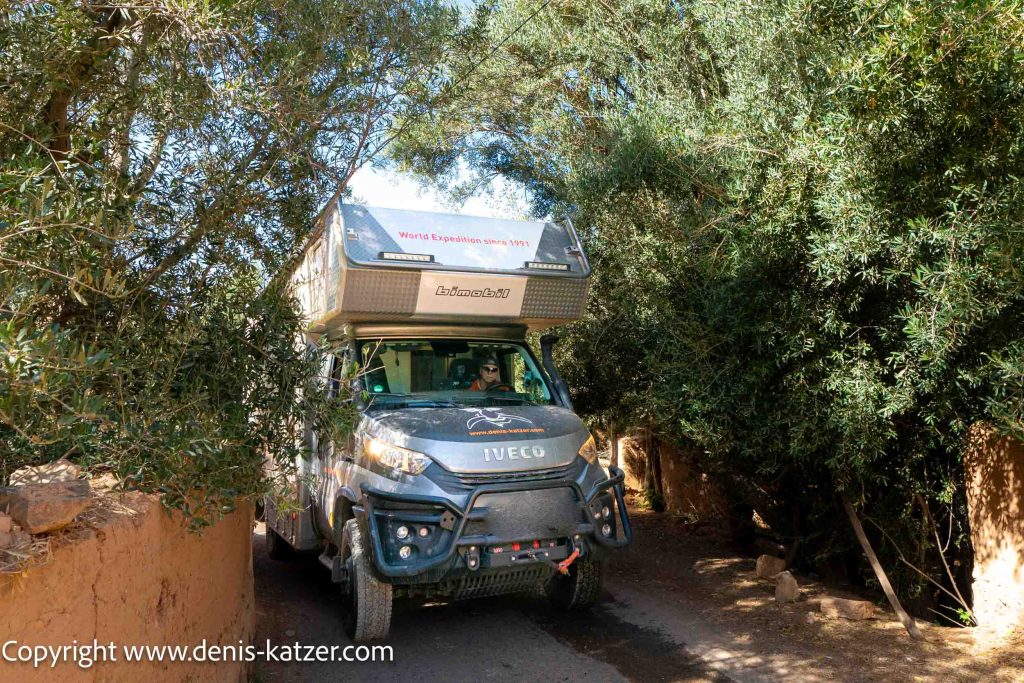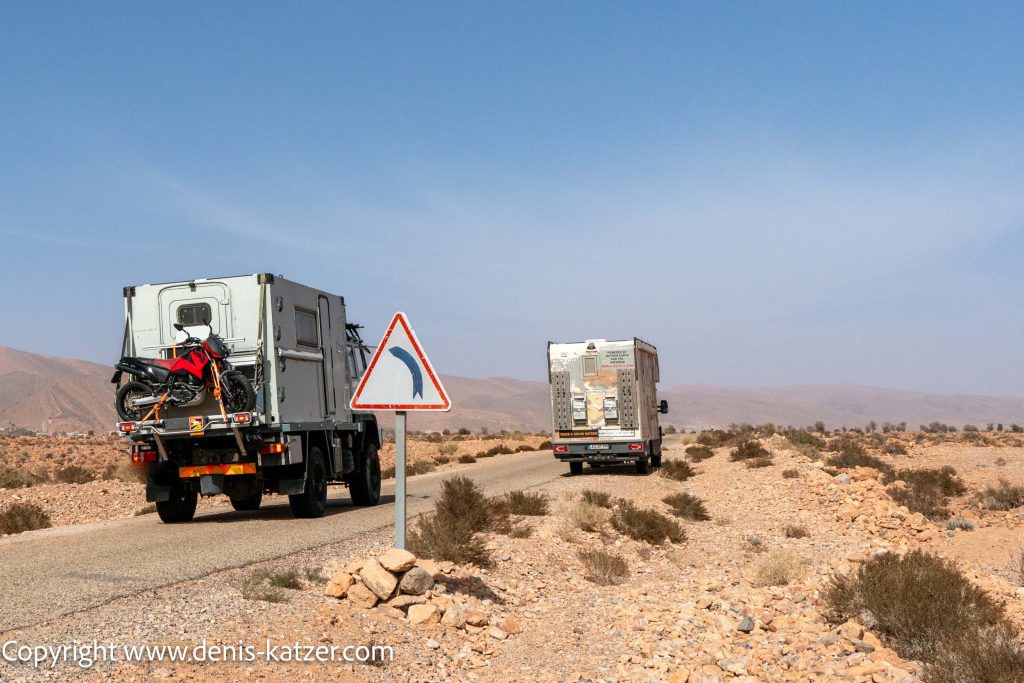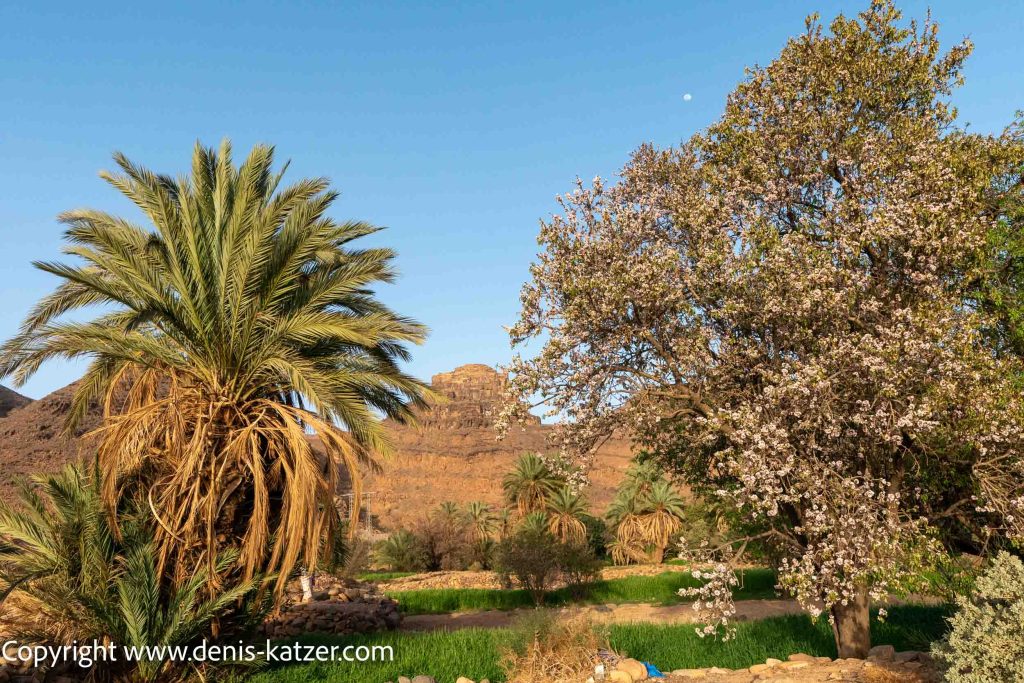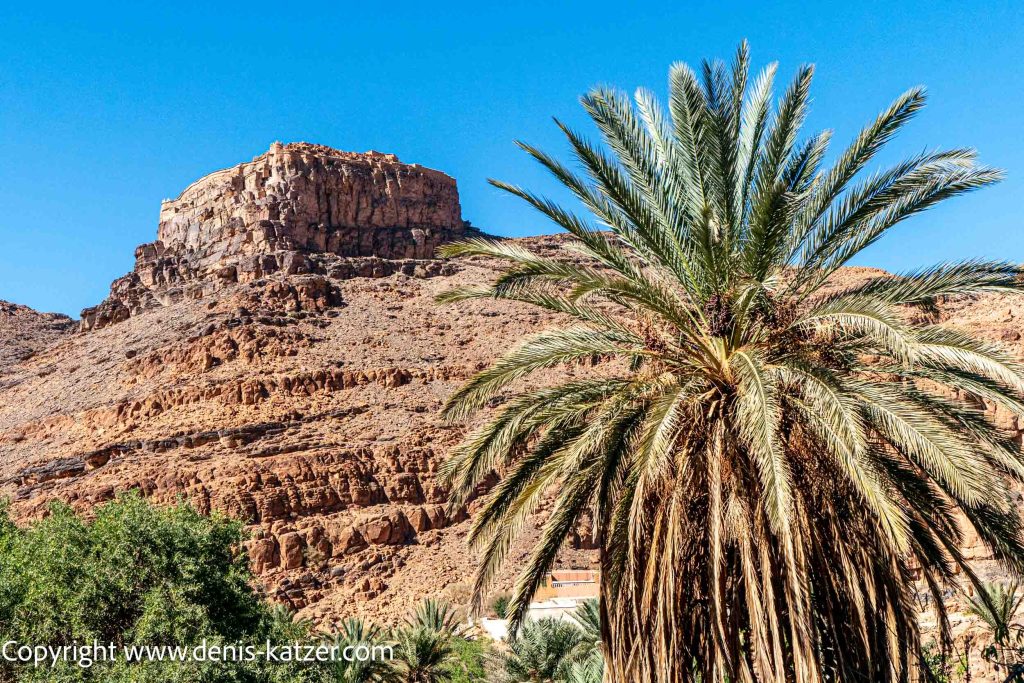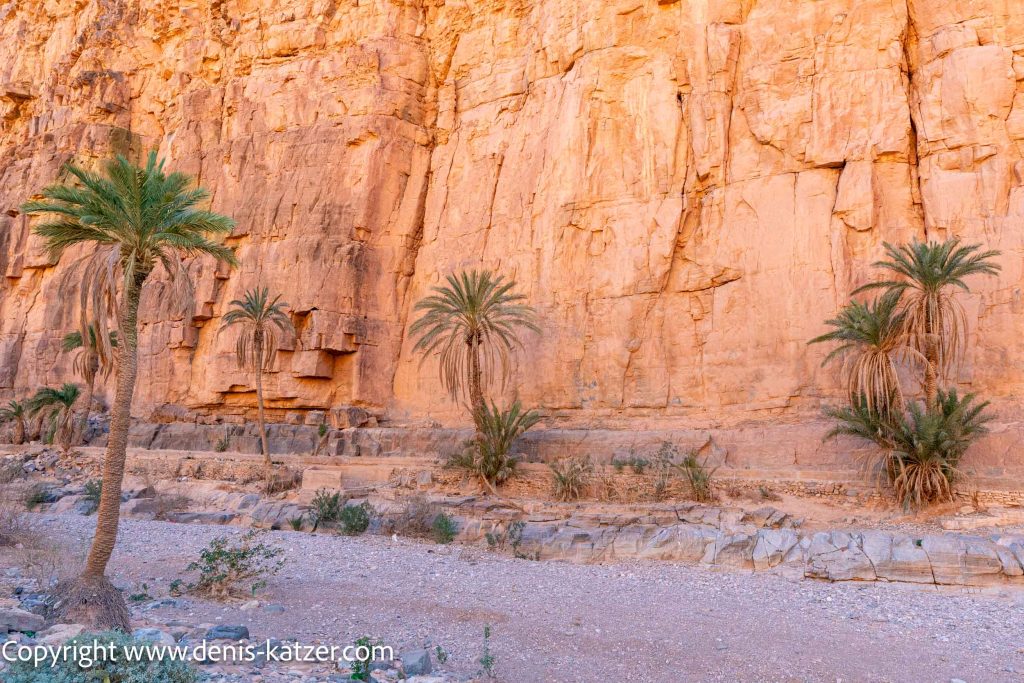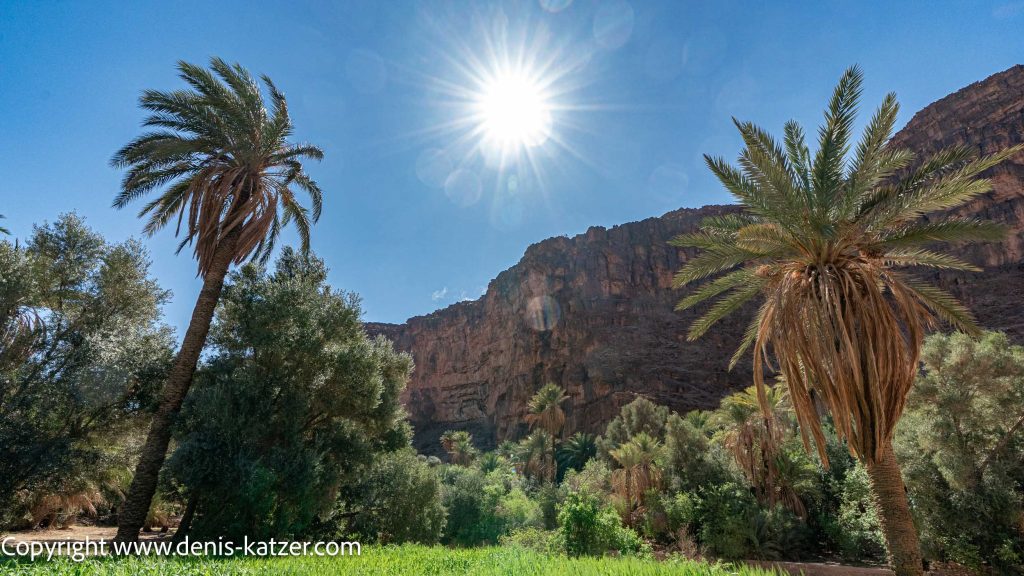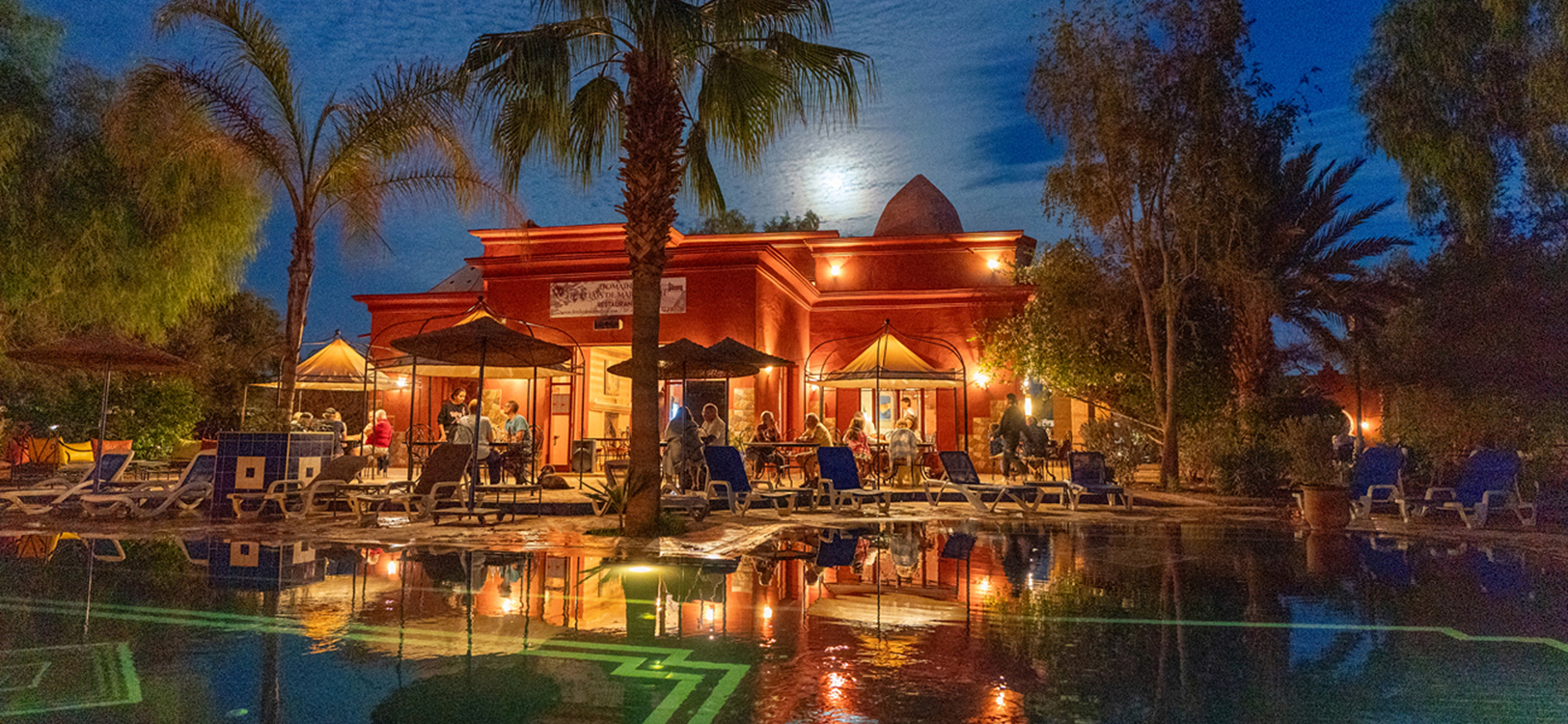
WITH EXPEDITIONSMOBIL INTO LOCATED OASES – Health and injuries while traveling
N 29°14'35.5" W 009°11'31.3"
Day: 02/18/2024 – 02/19/2024
Day: 443 – 444
Camp 81
Country: Morocco
Location: Amtoudj village
Latitude N: 29°14’35.5″
Longitude W: 009°11’31.3″
Total kilometers: 12,020 km
Altitude: 726 meters
Temperature day max: 22°
Night temperature: 10 °
We have left the small coastal town of Sidi Ifni on the Atlantic behind us and continue to the Id Aissa storage castle, also known as Agadir Id Aissa. The castle is said to have been perched on a high rocky outcrop above the desert for over 900 years, making it one of the oldest Berber buildings in the world. “Agadir” means “granary” in the Berber language. This storage castle is located in the Anti-Atlas Mountains, south of the city of Agadir, and is an absolute highlight for us that we definitely want to visit.
This time we want to delve deep into the impressive Anti-Atlas Mountains and visit the hidden villages that are considered the true treasures of Morocco. These villages are located in a breathtaking landscape and are characterized by their unique culture and traditional architecture. They mostly consist of charming adobe houses that blend harmoniously into the rocky surroundings and provide natural insulation against the extreme temperatures. Many of these villages are located around vital oases that enable the cultivation of crops and make the region green and fertile.
“Look how beautiful!” says Tanja, pointing to a palm grove next to the road. “A dream,” I reply, stopping on the right and taking a photo of the green patch in the middle of the reddish-brown, dry landscape. “There are many such beautiful places and oases in the Anti-Atlas Mountains,” I say. “And which ones would that be?” asks Tanja.
“Another remarkable village is Aït Mansour,” I reply. “It’s a popular destination for hikers and nature lovers, with its lush palm groves and impressive granite formations. Igherm, which lies at the foot of Jebel Siroua, is also a traditional Berber village, known for its lively markets and festivals,” I add. “The inhabitants of these villages mainly speak Tamazight, a Berber language, as well as Arabic. Their way of life is strongly influenced by agriculture; they grow grain, vegetables, olives and almonds and keep goats, sheep and chickens. Traditional festivals, weddings and religious celebrations are central components of social life. The clothing is colorful and often hand-woven, complemented by intricately crafted silver jewelry.” “Sounds interesting, my travel guide,” says Tanja with a laugh. “It’s great to have your own personal travel guide with you,” I reply, also laughing, and continue my explanation. “Nevertheless, the villages face challenges such as water scarcity, the migration of young people to the cities and the preservation of their traditional way of life in a modernizing world,” I say thoughtfully. “However, these villages in the Anti-Atlas are a living testimony to the adaptability and cultural richness of the Berbers and remain an indispensable part of Moroccan identity.”
“Do you know why so many of the houses and villages, the kasbahs and ksour, are in ruins today and in some cases resemble fields of ruins?” Tanja wants to know as I steer our Terra Love through a narrow passage bordered by meter-high walls of ruins.
“The answer lies in the fact that they were built from clay and, if not regularly maintained, are prone to erosion and decay. In addition, the region is seismically active, which means that numerous earthquakes have caused significant damage to the structures over the centuries. In addition, many settlements in the Anti-Atlas have been abandoned over time due to economic changes, water scarcity and migration to more urban areas.”
In order to see more of the original southern Morocco and its people living away from modern civilization, we avoid the R102 highway and try to make our way along narrow, little-used roads and tracks, some of which lead through romantic oases. This involves a risk, as we don’t know whether they will suddenly become impassable for our 3.65 meter high and 7.62 meter long Terra Love. And then that’s exactly what seems to happen. Suddenly, a passage overgrown with trees appears in front of us. “I’ll get out, then I can guide you through these branches,” says Tanja and leaves the Terra Love. As soon as she stands in front of our mobile, she signals to me to turn left. It cracks and crashes above me. The branch deflectors installed on the cab do their job. As we drive on, we not only come across passages overgrown with trees, but also dilapidated-looking little bridges and low-hanging power cables stretching across the road. As we don’t know whether it will continue like this for the next 50 or perhaps even 100 kilometers or whether it will get even narrower, and we don’t want to risk damaging our cabin or our entire expedition vehicle or causing damage to the village power grid, we decide to give in. We look for a turning point to start our retreat. “It’s best if I walk ahead again to scout the way,” says Tanja, because the track is so narrow that I can’t possibly turn our 7.62 meter long motorhome around. It takes us 20 minutes to finally find a suitable turning point. “Phew, it’s a good thing we turned around,” says Tanja with relief.
Of course, you could ask yourself at this point why we voluntarily put ourselves in such situations. Why we repeatedly leave the main route to explore the area on side routes and tracks, putting ourselves and our vehicle in situations that are not always pleasant and sometimes even dangerous. Well, what can I say? This is exactly what gives us pleasure, satisfies our curiosity, challenges us to a certain extent, rewards our spirit of adventure and often presents us with extraordinary encounters, landscapes and stories.
What’s it like for you? Do you also leave the main route from time to time to discover and experience new and unusual things despite the potential risks, or do you prefer to play it safe and are happy with the way things are? We would be very interested to hear your opinion. Feel free to write us your thoughts in the guestbook.
Health while traveling
As we continue our journey, we talk about our health, in particular the fact that we have often been surrounded by sand and sandstorms in recent months. As a result, I have contracted a severe eye infection, accompanied by constant, severe sneezing, which still plagues me. Sometimes it is so intense that it makes my life difficult and I have to lie down to recover from a sneezing attack. I seriously wonder whether the sneezing could have any effect on my health and the rest of our journey. A premonition creeps up on me and I sincerely hope that it’s just my imagination.
And while we’re on the subject of health: Over the many years of travel, we have been and continue to be asked how we have fared over the past four decades. Well, in the last 40 years, I’ve actually been hit quite often in this respect. The injuries have been extensive: herniated discs, paralysis, blindness, acromioclavicular joint injuries and many more, to name but a few. Diarrhea, conjunctivitis and ear infections, skin rashes as well as diarrheal diseases and parasites transmitted by mosquitoes or other animals were also a very unpleasant part of our travels. Fortunately, Tanja was much less affected than me. I think she is simply more robust and has a better immune system.
Getting sick on trips and expeditions is a nightmare and a serious challenge for the body and mind. What stresses me out the most every time I catch it again is the question: what have I caught and will it go away?
How do you feel about this topic? Have you ever been really ill during a trip? Were you also afraid that it wouldn’t get better? How do you prepare for such cases?
We always have a first-aid kit with us, which is based on our experience and covers any weak points that we know about. Even though we are not big fans of vaccinations, it is important to be vaccinated against one or two things before traveling to the tropics.
Basic vaccinations:
Vaccinations are a sensitive topic for many people, especially in this day and age. Nevertheless, we would like to mention a few vaccinations that can probably ensure survival in the event of infection.
For example, the tetanus vaccination:
Protection against tetanus, a bacterial infection.
Diphtheria:
Protection against a serious infectious disease
of the upper respiratory tract.
Whooping cough:
Protection against a highly contagious respiratory disease.
Polio:
Protection against polio.
Hepatitis A:
Protection against a viral infection that affects the liver, particularly important when traveling to developing countries.
Hepatitis B:
Protection against further liver inflammation,
which can become chronic.
Additional vaccinations for trips to the tropics:
Typhoid fever:
Protection against bacterial infection from contaminated food or water.
Cholera:
For stays in regions with cholera outbreaks.
Yellow fever:
A mandatory vaccination for travel to yellow fever areas, required for entry into certain countries in Africa and South America.
What do you think about vaccinations? Do you protect yourself or do you take your chances? We are very interested in these questions.
At the end of our list, perhaps a few useful tips:
Even after returning from a trip, it is important to take care of your health. If symptoms persist, it is advisable to consult a doctor, especially if you have been in malaria regions.
Tanja and I attended courses in “Medical care in remote regions” at Pro Medi GmbH run by Martin Eickhoff. We can definitely recommend this to you. You can find the link in the video description.
https://www.facebook.com/deniskatzer/videos/416331145873669
Oh yes, you should always have emergency numbers and the addresses of the German embassy to hand. A few basic language skills can also be very helpful in an emergency. We also always have copies of important documents such as vaccination certificates with us.
In the late afternoon, we reach the campsite near the oasis village of Amtoudi, which is located directly below the impressive Agadir Id Aissa granary castle.
From here we will hike tomorrow to the Speicherburg, one of the most historically significant architectural monuments in Morocco, which is deeply embedded in the culture and history of the Berber tribes.
Watch the video and let yourself be whisked away to another world.
Here is the link to the video:

